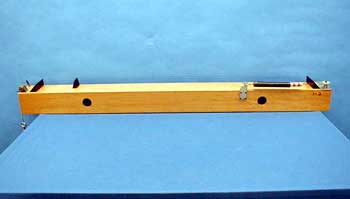Demos: 4B-10 Monochord

A wooden box has two long steel wires passing over the top from end to end. One end of each wire is anchored and the other attached to a tuning peg which enables the wire to be tightened. Each wire also passes over a small wooden bridge that can be moved back and forth. The bridge acts as a fret that effectively changes the length of the wire. By varying the tension in the wire and the length of the wire, various sound frequencies can be produced when the wires are plucked.
Directions: With the bridge in a fixed position, pluck the wire and slowly tighten it as you do so. The pitch will increase. Then without tightening the wire, move the bridge back and forth as the wire is plucked. If the bridge is placed exactly in the middle of the wire, the same frequency is heard on each side of the bridge. Each wire can be tuned separately to produced twin tones.
Suggestions for Presentation: Draw attention to a stringed instrument, such as a guitar. What is the purpose of tightening or loosening the string? What role do the frets play? Use the monochord to show how each affects the pitch of the string.
Applications: The tuning of stringed instruments.
Last Updated: Nov 30, 2023 11:25 AM